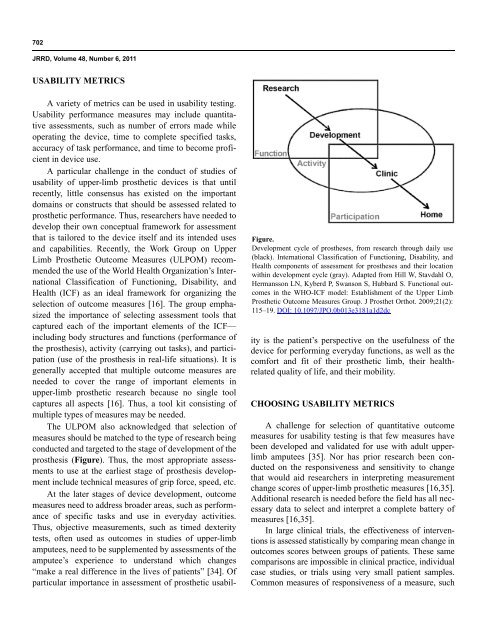Development and testing of new upper-limb prosthetic devices ...
Development and testing of new upper-limb prosthetic devices ...
Development and testing of new upper-limb prosthetic devices ...
You also want an ePaper? Increase the reach of your titles
YUMPU automatically turns print PDFs into web optimized ePapers that Google loves.
702<br />
JRRD, Volume 48, Number 6, 2011<br />
USABILITY METRICS<br />
Figure.<br />
<strong>Development</strong> cycle <strong>of</strong> prostheses, from research through daily use<br />
(black). International Classification <strong>of</strong> Functioning, Disability, <strong>and</strong><br />
Health components <strong>of</strong> assessment for prostheses <strong>and</strong> their location<br />
within development cycle (gray). Adapted from Hill W, Stavdahl O,<br />
Hermansson LN, Kyberd P, Swanson S, Hubbard S. Functional outcomes<br />
in the WHO-ICF model: Establishment <strong>of</strong> the Upper Limb<br />
Prosthetic Outcome Measures Group. J Prosthet Orthot. 2009;21(2):<br />
115–19. DOI: 10.1097/JPO.0b013e3181a1d2dc<br />
A variety <strong>of</strong> metrics can be used in usability <strong>testing</strong>.<br />
Usability performance measures may include quantitative<br />
assessments, such as number <strong>of</strong> errors made while<br />
operating the device, time to complete specified tasks,<br />
accuracy <strong>of</strong> task performance, <strong>and</strong> time to become pr<strong>of</strong>icient<br />
in device use.<br />
A particular challenge in the conduct <strong>of</strong> studies <strong>of</strong><br />
usability <strong>of</strong> <strong>upper</strong>-<strong>limb</strong> <strong>prosthetic</strong> <strong>devices</strong> is that until<br />
recently, little consensus has existed on the important<br />
domains or constructs that should be assessed related to<br />
<strong>prosthetic</strong> performance. Thus, researchers have needed to<br />
develop their own conceptual framework for assessment<br />
that is tailored to the device itself <strong>and</strong> its intended uses<br />
<strong>and</strong> capabilities. Recently, the Work Group on Upper<br />
Limb Prosthetic Outcome Measures (ULPOM) recommended<br />
the use <strong>of</strong> the World Health Organization’s International<br />
Classification <strong>of</strong> Functioning, Disability, <strong>and</strong><br />
Health (ICF) as an ideal framework for organizing the<br />
selection <strong>of</strong> outcome measures [16]. The group emphasized<br />
the importance <strong>of</strong> selecting assessment tools that<br />
captured each <strong>of</strong> the important elements <strong>of</strong> the ICF—<br />
including body structures <strong>and</strong> functions (performance <strong>of</strong><br />
the prosthesis), activity (carrying out tasks), <strong>and</strong> participation<br />
(use <strong>of</strong> the prosthesis in real-life situations). It is<br />
generally accepted that multiple outcome measures are<br />
needed to cover the range <strong>of</strong> important elements in<br />
<strong>upper</strong>-<strong>limb</strong> <strong>prosthetic</strong> research because no single tool<br />
captures all aspects [16]. Thus, a tool kit consisting <strong>of</strong><br />
multiple types <strong>of</strong> measures may be needed.<br />
The ULPOM also acknowledged that selection <strong>of</strong><br />
measures should be matched to the type <strong>of</strong> research being<br />
conducted <strong>and</strong> targeted to the stage <strong>of</strong> development <strong>of</strong> the<br />
prosthesis (Figure). Thus, the most appropriate assessments<br />
to use at the earliest stage <strong>of</strong> prosthesis development<br />
include technical measures <strong>of</strong> grip force, speed, etc.<br />
At the later stages <strong>of</strong> device development, outcome<br />
measures need to address broader areas, such as performance<br />
<strong>of</strong> specific tasks <strong>and</strong> use in everyday activities.<br />
Thus, objective measurements, such as timed dexterity<br />
tests, <strong>of</strong>ten used as outcomes in studies <strong>of</strong> <strong>upper</strong>-<strong>limb</strong><br />
amputees, need to be supplemented by assessments <strong>of</strong> the<br />
amputee’s experience to underst<strong>and</strong> which changes<br />
“make a real difference in the lives <strong>of</strong> patients” [34]. Of<br />
particular importance in assessment <strong>of</strong> <strong>prosthetic</strong> usability<br />
is the patient’s perspective on the usefulness <strong>of</strong> the<br />
device for performing everyday functions, as well as the<br />
comfort <strong>and</strong> fit <strong>of</strong> their <strong>prosthetic</strong> <strong>limb</strong>, their healthrelated<br />
quality <strong>of</strong> life, <strong>and</strong> their mobility.<br />
CHOOSING USABILITY METRICS<br />
A challenge for selection <strong>of</strong> quantitative outcome<br />
measures for usability <strong>testing</strong> is that few measures have<br />
been developed <strong>and</strong> validated for use with adult <strong>upper</strong><strong>limb</strong><br />
amputees [35]. Nor has prior research been conducted<br />
on the responsiveness <strong>and</strong> sensitivity to change<br />
that would aid researchers in interpreting measurement<br />
change scores <strong>of</strong> <strong>upper</strong>-<strong>limb</strong> <strong>prosthetic</strong> measures [16,35].<br />
Additional research is needed before the field has all necessary<br />
data to select <strong>and</strong> interpret a complete battery <strong>of</strong><br />
measures [16,35].<br />
In large clinical trials, the effectiveness <strong>of</strong> interventions<br />
is assessed statistically by comparing mean change in<br />
outcomes scores between groups <strong>of</strong> patients. These same<br />
comparisons are impossible in clinical practice, individual<br />
case studies, or trials using very small patient samples.<br />
Common measures <strong>of</strong> responsiveness <strong>of</strong> a measure, such

















